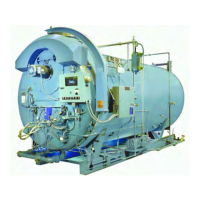Chapter 3 — Waterside Care and Requirements
Part No. 750-184 3-11
(6) Fill the pressure vessel with clean water until the top of the
tubes are covered. Add the cleaning solution and then fill to the top.
The temperature of the water used in the initial fill should be at
ambient temperature.
(7) The boiler should then be fired intermittently at a low rate
sufficient to hold solution just at the boiling point. Boil the water for
at least five hours. Do not produce steam pressure.
(8) Allow a small amount of fresh water to enter the boiler to create
a slight overflow that will carry off surface impurities.
(9) Continue the boil and overflow process until the water clears.
Shut the burner down.
(10) Let the boiler cool to 120°F or less.
Be sure to drain the hot water to a safe point of discharge to avoid
scalding.Failure to follow these instructions could result in serious
personal injury or death
(11) Remove handhole plates and wash the waterside surfaces
thoroughly using a high pressure water stream.
(12) Inspect the surfaces. If they are not clean, repeat the boil out.
(13) After closing the handholes and reinstalling the safety or relief
valves, fill the boiler and fire it until the water is heated to at least
180°F to drive off any dissolved gases, which might otherwise
corrode the metal.
The above procedure may be omitted in the case of a unit previously
used or known to be internally clean. However, consideration must
be given to the possibility of contaminating materials entering the
boiler from the system.
On a steam system, the condensate should be wasted until tests
show the elimination of undesirable impurities. During the period
that condensate is wasted, be sure make-up water is treated to
prevent an accumulation of unwanted materials or corrosion.
On a hot water system, chemical cleaning is generally necessary
and the entire system should be drained after treatment. Consult
your local Cleaver-Brooks authorized representative for
recommendations, cleaning compounds, and application
procedures.

